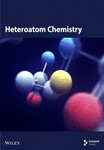Asymmetric oxidation and determination of the configurations of an optically pure sulfoxide and an I-menthoxysulfonium salt of 1,9-bis(methylthio)dibenzothiophene by x-ray crystallographic analysis
Abstract
1,9-Bis(methylthio)dibenzothiophene (1a) was treated with one equivalent of bromine and pyridine in the presence of l-menthol and then with aqueous sodium hydroxide to give optically active 1-(methylsulfinyl)-9-(methylthio)dibenzothiophene (2a) enriched by the S isomer (ee: 57%). The configuration of optically pure sulfoxide (2a) was determined by X-ray crystallographic analysis to be the S configuration at the sulfinyl sulfur atom. On the other hand, 1-(methyl-l-menthoxysulfonio)-9-(methylthio)dibenzothiophene tetrafluoroborate (4a) was isolated as an intermediate of this asymmetric oxidation in an optically pure form, as yellow crystals. The absolute configuration of this sulfonium salt (4a) was verified by X-ray crystallographic analysis as the R configuration. Optically pure sulfonium salt (4a) also gave partially optically active sulfoxide (2a) with net inversion on its hydrolysis. It was suggested that the hydrolysis reaction of the sulfonium salt (4a) accordingly proceeds, not only via a sulfurane having a simple SN2 type of geometry but also by a front side attack ofhydroxide anion, with respect to the l-menthoxy group, on sulfur, and the sequential elimination of the l-menthoxy group from the tetracoordinated intermediate. © 1996 John Wiley & Sons, Inc.




